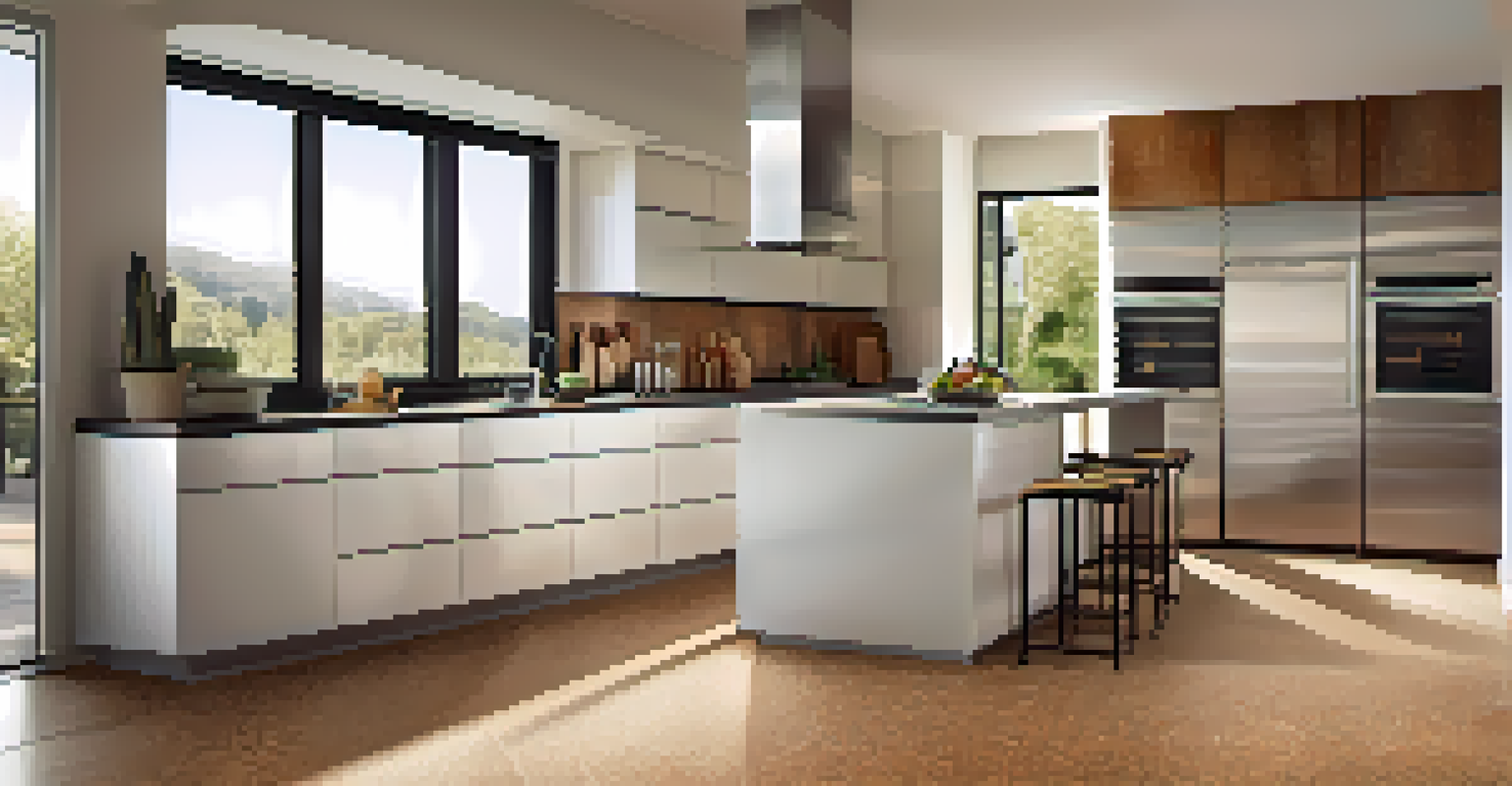The Impact of Eco-Friendly Flooring Options

Understanding Eco-Friendly Flooring Materials
Eco-friendly flooring options range from bamboo and cork to recycled materials. These materials are sourced sustainably, meaning they have a lower environmental impact compared to traditional flooring like hardwood or carpet. For instance, bamboo grows incredibly fast, making it a renewable resource that can be harvested without damaging the ecosystem.
The greatest threat to our planet is the belief that someone else will save it.
Moreover, eco-friendly flooring often uses non-toxic adhesives and finishes, which improves indoor air quality. This is especially vital for families with children or pets, as harmful chemicals can linger in the air and surfaces. Choosing sustainable materials is not just a trend; it's a step toward healthier living spaces.
By opting for eco-friendly flooring, homeowners can contribute to reducing their carbon footprint. This choice not only supports sustainable practices but also promotes a more conscious lifestyle that resonates with environmental values.
Benefits of Eco-Friendly Flooring for Your Home
One of the most appealing benefits of eco-friendly flooring is its durability. Materials like bamboo and cork are naturally resistant to wear and tear, which means they can last for years without needing replacement. This longevity not only saves money in the long run but also reduces waste, as fewer materials end up in landfills.

Additionally, eco-friendly flooring options are often easier to maintain. For example, cork is naturally antimicrobial and resistant to mold, making it a great choice for kitchens and bathrooms. A simple sweep or occasional damp mop is usually all that's needed to keep these floors looking fresh.
Homeowners can also enjoy a unique aesthetic appeal with eco-friendly options. Many sustainable materials offer stunning natural patterns and textures that can elevate the look of any room. Whether you prefer a modern, minimalist design or a cozy, rustic feel, there's likely an eco-friendly option that fits your style.
The Environmental Impact of Traditional Flooring
Traditional flooring options often involve extensive deforestation and the use of harmful chemicals. For example, the production of conventional hardwood floors contributes to habitat loss and greenhouse gas emissions. This can lead to broader ecological issues, such as decreased biodiversity and climate change.
Sustainability is no longer about doing less harm. It's about doing more good.
Moreover, many carpets are made from synthetic fibers, which are derived from petroleum. The manufacturing process not only consumes a significant amount of energy but also releases toxins into the environment. When these carpets are discarded, they can take decades to decompose, further exacerbating waste management challenges.
By understanding the environmental impact of traditional flooring, homeowners can make more informed choices. Switching to eco-friendly flooring is a proactive step toward reducing one's ecological footprint and promoting sustainability.
Cost Considerations of Eco-Friendly Flooring
While eco-friendly flooring options can sometimes have a higher upfront cost, they often pay off over time. The durability of materials like bamboo means homeowners may not need to replace their floors as often, leading to long-term savings. Additionally, the low maintenance requirements can further reduce overall costs.
It's also worth noting that many eco-friendly flooring options are becoming more accessible and competitively priced as demand increases. As manufacturers innovate and expand their offerings, prices are likely to continue to drop, making sustainable choices more attainable for everyone.
Investing in eco-friendly flooring can also enhance the resale value of a home. Many buyers today are looking for sustainable features, and having eco-friendly flooring can make a property stand out in a competitive market.
Installation Process for Eco-Friendly Flooring
The installation of eco-friendly flooring can vary depending on the material chosen. For instance, cork tiles often come with a simple click-lock installation system, making it a DIY-friendly option for those who enjoy home improvement projects. This ease of installation can save on labor costs as well.
However, some materials, like solid bamboo or reclaimed wood, may require professional installation to ensure proper fitting and finish. It's essential to choose a contractor familiar with eco-friendly products to guarantee the best results. This ensures that the integrity of the sustainable materials is maintained throughout the process.
Regardless of the method chosen, the installation of eco-friendly flooring often aligns with sustainable practices. Many manufacturers focus on reducing waste during production and installation, contributing to a greener home environment.
Maintaining Eco-Friendly Flooring for Longevity
Proper maintenance is key to ensuring the longevity of eco-friendly flooring. Regular cleaning with non-toxic products helps preserve the natural beauty of materials like bamboo and cork. It's important to avoid harsh chemicals that can damage the finish and the environment.
Additionally, taking care of these floors often involves simple practices. For example, placing mats at entryways can minimize dirt and debris, which helps reduce wear and tear. Furthermore, using furniture pads can prevent scratches, ensuring your eco-friendly flooring continues to look its best.
Creating a maintenance routine not only extends the life of your floors but also reinforces your commitment to sustainability. By caring for your eco-friendly flooring, you're investing in both your home and the planet.
The Future of Eco-Friendly Flooring Solutions
The future of eco-friendly flooring looks promising as technology advances and sustainability becomes a priority for consumers. Innovations in material sourcing and production processes are leading to even more sustainable options. For instance, new techniques are emerging that allow for greater recycling and repurposing of materials.
Moreover, as awareness grows about climate change and environmental issues, more homeowners are likely to seek out eco-friendly solutions. This shift in consumer preferences will continue to drive manufacturers to develop better, more sustainable flooring options that meet market demand.

Ultimately, the movement toward eco-friendly flooring reflects a broader cultural shift toward sustainability. By embracing these solutions, we can contribute to a healthier planet for future generations while enjoying beautiful, durable flooring in our homes.